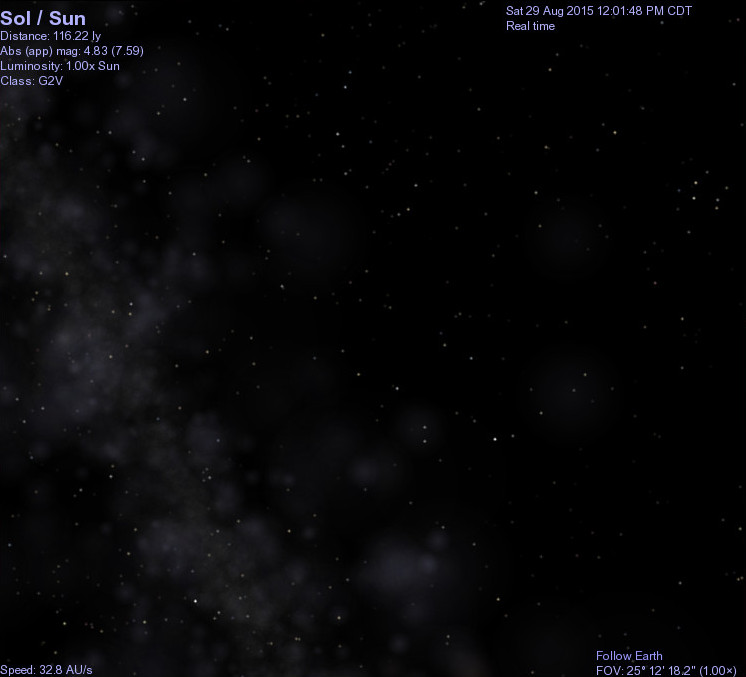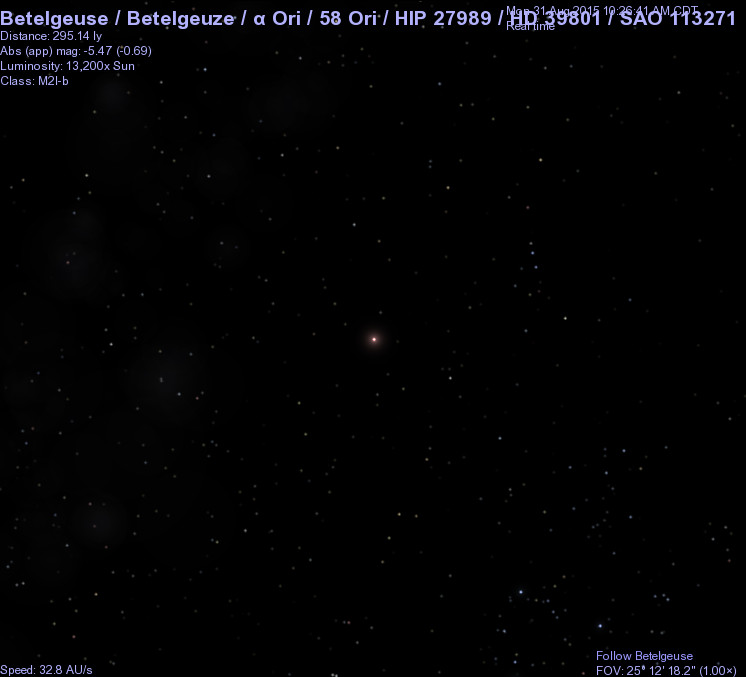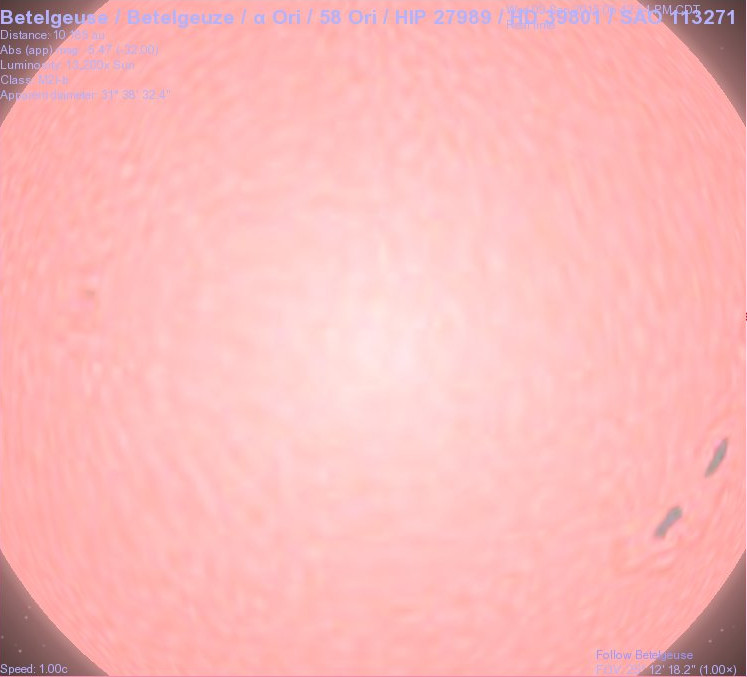Let's Go To Betelgeuse!
With Celestia
Day 1
Day 2
Day 4
Day 6
Day 9
Day 11
Day 11.5
Day 13
Day 14
Day 15
|
Greetings. This is going to be a bit of an interactive webpage for a little virtual trip I'm taking. Rather than go to some boring place like Australia, or Switzerland, I figured I'd set my sights a little bit more exotically. The destination: Betelgeuse. It's 497.58 light years away, so it will take a little while. Fortunately, I'm not limted by such mundane things as the speed of light or anything like that on this trip, else I'd probably be too old when I got there to have any real fun. How am I getting there? Well, I'm glad you asked. My primary method of transport will be the program Celestia. According to the fine folks who wrote Celestia, it is "The free space simulation that lets you explore our universe in three dimensions. Celestia runs on Windows, Linux, and Mac OS X." I call it a universe simulator. Play with it for a while and you'll see what I mean. We could get there with just a few keystrokes of the Celestia program, but that wouldn't really be any fun. Instead, first we're going to look at a couple of things. We'll start at the Earth. It's a somewhat familiar place to most of you. This is a view of earth from about 42,000 kilometers above the planet.  Let's take a quick look at what the Sun looks like from Earth, as it ties rather neatly into the end goal of this little trip.  Yup. That's the sun. from here it's pretty uninteresting. It's also not safe to look at it for too long, so we'll back off from the Sun a bit and in the process make it a little more managable. The screen shot below shows Pluto from about 30,000 kilometers out.  Now let's look at the Sun and see if it is any better from here.  Ah yes, much better since we're about 33 AU away. An AU, for those not privy, is an Astronomical Unit which is the approximate distance the Earth is from the Sun. That's about 15,000,000 kilometers, or 93,000,000 miles. So we're currently 4,936,729,743 kilometers from the Sun, which means it won't destroy your eyes quite so fast if you stare at it. Why is this distance important? I'm glad you asked. You see, we're taking a trip to Betelgeuse, which is, as I said about 500 light years away. If we wanted to travel there and were limited to the speed of light, we'd have my great, great, great, great, great, great, great, etc. grandson updating this page (probably from Mars) if we humans are still kicking about by then. Fortunately for us, Celestia isn't limited to the speed of light. So I could go one light year per second, and get there in about 8 minutes or so, but what would be the fun of that. Instead, I've chosen another rediculous speed, but one that we can perhaps relate to just a little bit better than Warp 9 or whatever. We're going to make our trip travelling at 33 AU per second. That means that if you start from Earth, you'll pass Pluto before the first second is up. That's pretty spectacularly fast. However, distances being what they are in space, that still isn't as fast as you might think. We begin the trip as shown below August 26, 2015 at 10:30 PM CDT. How long will this trip take? Let's find out.  Well, it's been not quite 24 hours since the beginning of my voyage. As you can see, I'm still 456 LY from Betelgeuse. Looks like it's going to take a little longer than I initially planned.  Fortunately, I am well provisioned with all the essentials of life...  Well, here we are on day 4. We're now 382 LY from Betelgeuse. It's still just a fairly bright star ahead of us.  Thankfully, I haven't run out of beer yet. Not much to see when looking back towards home, which is now 116 LY behind us. I don't think anyone delivers Shiner this far.  Check it out folks, I've got less than 300 LY to go. That means I've travelled 200 LY. It looks like I'm pretty much way out in the middle of nowhere. The big question I have at this point, is "do I still have cell service?"  Thursday, September 3, 2015 5:39 PM CDT Well, I've travelled 350 LY so far. Only about 150 LY left to go. Next time I plan a trip like this, I'll pack in a lot more beer.  Saturday September 5, 2015 12:09 AM CDT At long last, it is finally starting to look like there is an end in sight. Here we are, only 90 LY from our destination. It's been 11 days so far, and I'm really thankful that I was able to find someone who could ship me some fresh Shiner Oktoberfest beer, to help make the miles fly by. We're still zipping along, covering the distance between the Earth and Pluto every single second. Perhaps it's time to bring a little bit of math into this. We know that light travels at about 300,000 kilometers per second, 186,000 miles per second, however you prefer to measure it. I'm going to stick with metrics for this because math is almost always easier with metric units. One Astronomical Unit (AU) is 149597871 kilometers (~93 million miles). We're travelling at 32.8 AU/sec, which is 4,906,810,168 kilometers (3,048,950,484 miles/sec). That's pretty darn fast by almost any reckoning. At the moment we've travelled about 407 LY, which works out to 25,738,568 AU, 2,392,549,424,410,000 miles or 3,850,435,060,880,000 kilometers. The numbers have simply gotten so large that really the only way to think of it is in terms of light years, because even 25.7 million AU is hard to imagine.  Saturday September 5, 2015 3:09 PM CDT To anyone who might be reading this. Occasionally as one travels along extraordinary roads, normal everyday life intervenes. However, those journeys once started should never really be abandoned. Such is the case today. So, while life intervenes, we'll not put the big kibosh to this particular voyage, but will rather hold it in abeyance. Because I need to take care of things, and cannot continue to pay enough attention to piloting this ship to safely allow us to reach our destination on schedule, I've decided to lower my velocity to a mere 1 AU per second. Given the distance that is yet to be obtained (specifically about 62 LY yet in play), I can safely lower my cruising velocity and yet will still reach my destination once I am able to return to it. I'll post again once our normal travels have returned. We'll travel thus for a couple of days I suspect.  Monday, September 7, 2015 4:17 PM CDT Hello all, we're back from our little side trip and have resumed our normal speed. Right at the moment, we are at 59 LY, so you can see that travelling at a measly 1 AU per second is quite a slow down from our regular rate of speed, which we've now picked back up. No screen shot at the moment, because there really isn't a change to speak of from our last update. Thanks for hanging in there with me. Tuesday, September 8, 2015 11:27 PM CDT We're almost there! Only 10 more light years to travel. However, it's pretty late. I suspect we'd be arriving in just a very few more hours. I don't particularly fancy getting up at 3am to finish this little narrative. So, once again, we're going to slow down a bit whilst I get a bit of much needed sleep. We'll be dropping back down to about 7.39 AU per second. By my count that puts us about 19 hours away. As I have a lot of stuff to do tomorrow, that's probably a pretty good target.  Tuesday, September 9, 2015 6:17 PM CDT WooHoo! We're here! Take a look at that rather massive star we now see before us. You'll note we're 277 AU from our destination, yet it looms quite large. Go back to Day 1 and compare it to the Sun as seen from about 33 AU. We're now many times further than we were, yet the star looms much larger than our own dear Sun.  Now we've finally come to the real point of this entire expedition. Now, the thing to keep in mind here, is that the "distance" to the star we are talking about, is actually the distance to the center of the object. We're not actually talking about the surface of the star, such that it is. So, we're going to pretend for a moment that we've dropped Betelgeuse right smack dab into the middle of the solar system. Sad to say, it would completely consume our piddly little star without so much as a fair-thee-well. So, now that we've committed this huge ecological atrocity, let's see how things look from different vantage points in the solar system, starting with Pluto.  OK, is that impressive or what? Next comes Neptune. Here's what Betelgeuse would look like in your sky. It's not really much different than Pluto, because they are both approximately the same distance from our sun at the moment.  The view from Uranus would be even more impressive.  From Saturn it would fill up most of the sky.  From Jupiter, it would be downright frightening. I suspect you'd actually be inside the corona, which would probably get pretty hot. Though the surface temperature of the Sun is a few thousand degrees, the corona can reach a million degrees easily.  I'd take you to Mars, but that's not really possible. Though Mars is 1.61 AU from the Sun, the actual surface of Betelgeuse extends to 2.78 AU. That means that Mars, Earth Venus, and Mercury are all actually inside the star itself. Opps. It would probably be kind of difficult living anywhere in the vicinity of Betelgeuse unless you were somewhat further than Pluto. Even the Voyager I spacecraft is only about 100 AU from the Sun, which would be uncomfortably close to Betelgeuse.  I hope you've enjoyed our little exploration. Next time, I'll plot out the distance and time better. |